HPWS Implementation Analysis and Recommendations for HealthReach
VerifiedAdded on 2022/09/29
|5
|1028
|53
Report
AI Summary
This report examines High Performance Work Systems (HPWS) within the context of the healthcare industry, specifically addressing the challenges of employee turnover, retention, and organizational commitment. The analysis draws upon several research articles to explore the benefits of HPWS, including improved employee commitment, reduced turnover rates, and enhanced organizational performance. The report highlights the importance of human resources in healthcare and the need for effective human resource management practices. Key components of HPWS, such as job infrastructure, information sharing, compensation, training programs, and employee involvement, are discussed. The report concludes by promoting the adoption of HPWS by HealthReach, emphasizing the potential for positive outcomes and a "win-win" scenario for both employees and the organization. The research suggests that proper implementation of HPWS can lead to better employee satisfaction and organizational success.
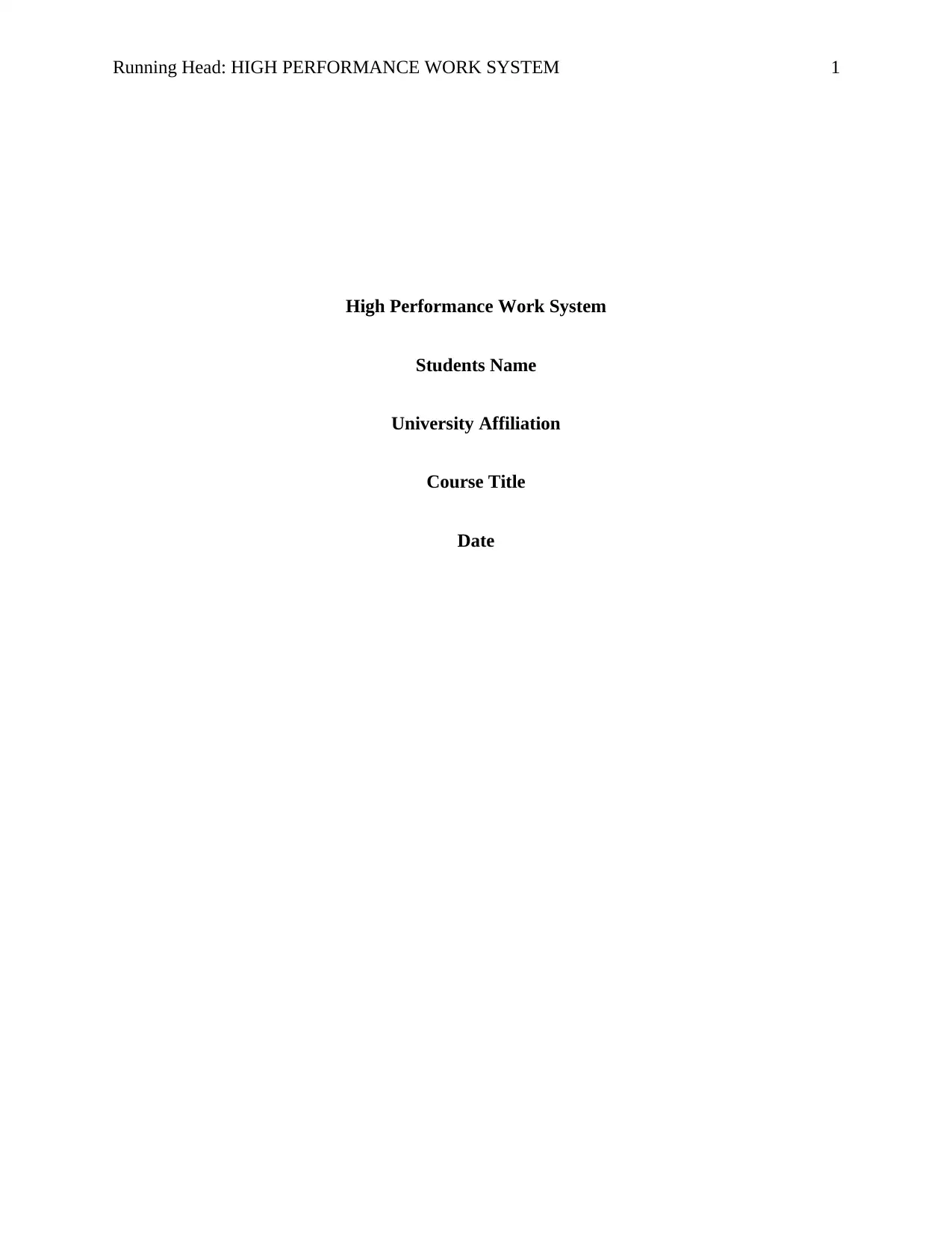
Running Head: HIGH PERFORMANCE WORK SYSTEM 1
High Performance Work System
Students Name
University Affiliation
Course Title
Date
High Performance Work System
Students Name
University Affiliation
Course Title
Date
Paraphrase This Document
Need a fresh take? Get an instant paraphrase of this document with our AI Paraphraser
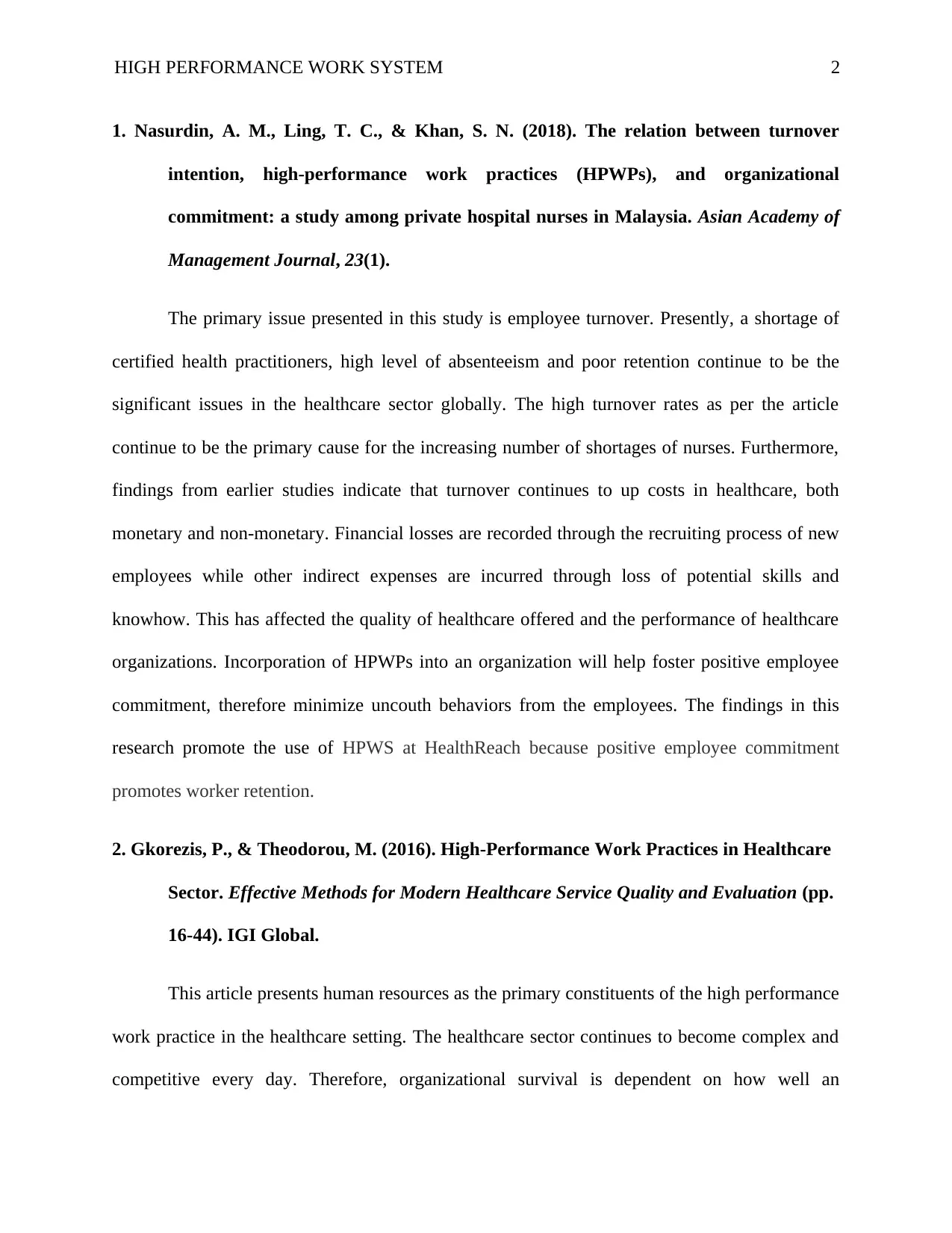
HIGH PERFORMANCE WORK SYSTEM 2
1. Nasurdin, A. M., Ling, T. C., & Khan, S. N. (2018). The relation between turnover
intention, high-performance work practices (HPWPs), and organizational
commitment: a study among private hospital nurses in Malaysia. Asian Academy of
Management Journal, 23(1).
The primary issue presented in this study is employee turnover. Presently, a shortage of
certified health practitioners, high level of absenteeism and poor retention continue to be the
significant issues in the healthcare sector globally. The high turnover rates as per the article
continue to be the primary cause for the increasing number of shortages of nurses. Furthermore,
findings from earlier studies indicate that turnover continues to up costs in healthcare, both
monetary and non-monetary. Financial losses are recorded through the recruiting process of new
employees while other indirect expenses are incurred through loss of potential skills and
knowhow. This has affected the quality of healthcare offered and the performance of healthcare
organizations. Incorporation of HPWPs into an organization will help foster positive employee
commitment, therefore minimize uncouth behaviors from the employees. The findings in this
research promote the use of HPWS at HealthReach because positive employee commitment
promotes worker retention.
2. Gkorezis, P., & Theodorou, M. (2016). High-Performance Work Practices in Healthcare
Sector. Effective Methods for Modern Healthcare Service Quality and Evaluation (pp.
16-44). IGI Global.
This article presents human resources as the primary constituents of the high performance
work practice in the healthcare setting. The healthcare sector continues to become complex and
competitive every day. Therefore, organizational survival is dependent on how well an
1. Nasurdin, A. M., Ling, T. C., & Khan, S. N. (2018). The relation between turnover
intention, high-performance work practices (HPWPs), and organizational
commitment: a study among private hospital nurses in Malaysia. Asian Academy of
Management Journal, 23(1).
The primary issue presented in this study is employee turnover. Presently, a shortage of
certified health practitioners, high level of absenteeism and poor retention continue to be the
significant issues in the healthcare sector globally. The high turnover rates as per the article
continue to be the primary cause for the increasing number of shortages of nurses. Furthermore,
findings from earlier studies indicate that turnover continues to up costs in healthcare, both
monetary and non-monetary. Financial losses are recorded through the recruiting process of new
employees while other indirect expenses are incurred through loss of potential skills and
knowhow. This has affected the quality of healthcare offered and the performance of healthcare
organizations. Incorporation of HPWPs into an organization will help foster positive employee
commitment, therefore minimize uncouth behaviors from the employees. The findings in this
research promote the use of HPWS at HealthReach because positive employee commitment
promotes worker retention.
2. Gkorezis, P., & Theodorou, M. (2016). High-Performance Work Practices in Healthcare
Sector. Effective Methods for Modern Healthcare Service Quality and Evaluation (pp.
16-44). IGI Global.
This article presents human resources as the primary constituents of the high performance
work practice in the healthcare setting. The healthcare sector continues to become complex and
competitive every day. Therefore, organizational survival is dependent on how well an
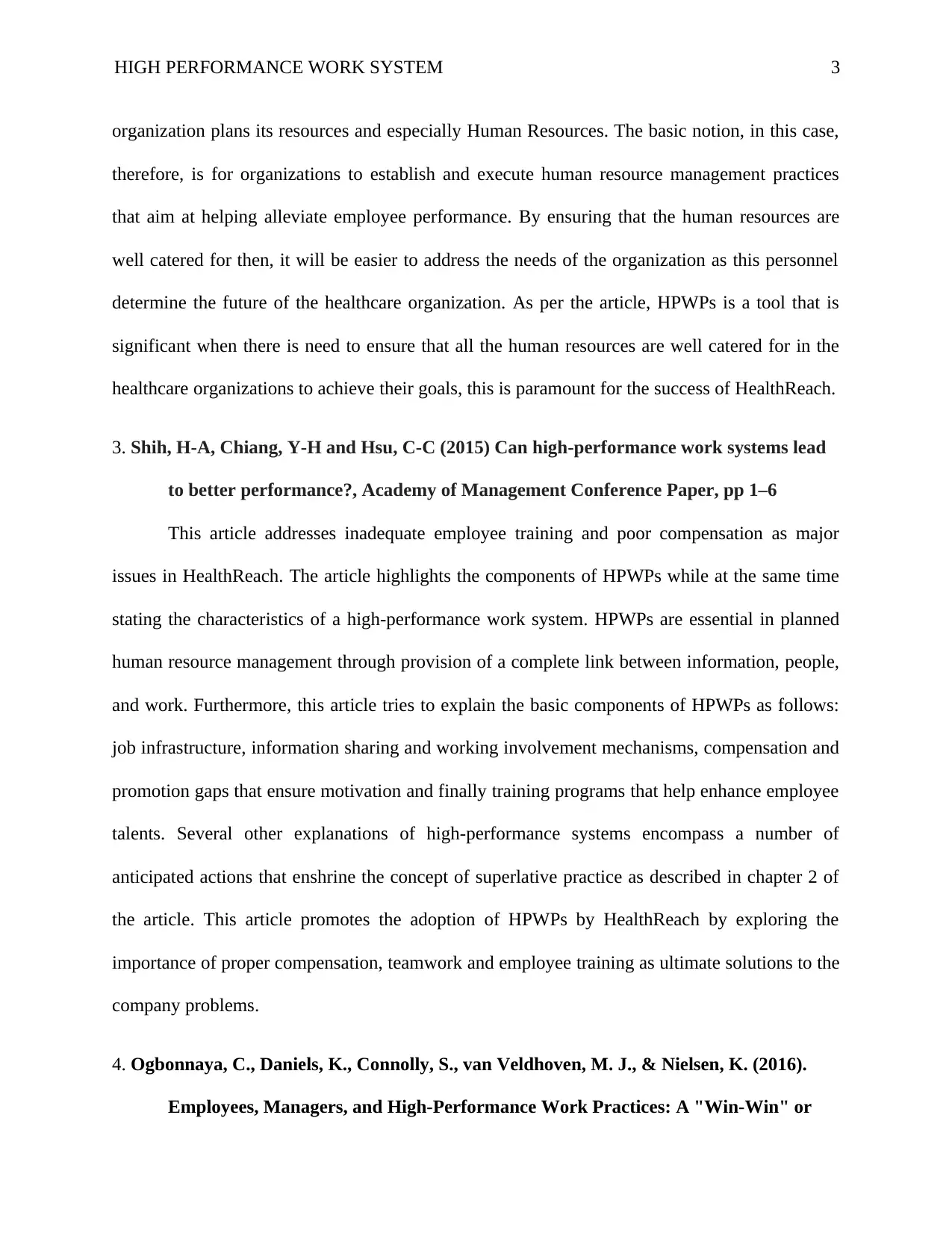
HIGH PERFORMANCE WORK SYSTEM 3
organization plans its resources and especially Human Resources. The basic notion, in this case,
therefore, is for organizations to establish and execute human resource management practices
that aim at helping alleviate employee performance. By ensuring that the human resources are
well catered for then, it will be easier to address the needs of the organization as this personnel
determine the future of the healthcare organization. As per the article, HPWPs is a tool that is
significant when there is need to ensure that all the human resources are well catered for in the
healthcare organizations to achieve their goals, this is paramount for the success of HealthReach.
3. Shih, H-A, Chiang, Y-H and Hsu, C-C (2015) Can high-performance work systems lead
to better performance?, Academy of Management Conference Paper, pp 1–6
This article addresses inadequate employee training and poor compensation as major
issues in HealthReach. The article highlights the components of HPWPs while at the same time
stating the characteristics of a high-performance work system. HPWPs are essential in planned
human resource management through provision of a complete link between information, people,
and work. Furthermore, this article tries to explain the basic components of HPWPs as follows:
job infrastructure, information sharing and working involvement mechanisms, compensation and
promotion gaps that ensure motivation and finally training programs that help enhance employee
talents. Several other explanations of high-performance systems encompass a number of
anticipated actions that enshrine the concept of superlative practice as described in chapter 2 of
the article. This article promotes the adoption of HPWPs by HealthReach by exploring the
importance of proper compensation, teamwork and employee training as ultimate solutions to the
company problems.
4. Ogbonnaya, C., Daniels, K., Connolly, S., van Veldhoven, M. J., & Nielsen, K. (2016).
Employees, Managers, and High-Performance Work Practices: A "Win-Win" or
organization plans its resources and especially Human Resources. The basic notion, in this case,
therefore, is for organizations to establish and execute human resource management practices
that aim at helping alleviate employee performance. By ensuring that the human resources are
well catered for then, it will be easier to address the needs of the organization as this personnel
determine the future of the healthcare organization. As per the article, HPWPs is a tool that is
significant when there is need to ensure that all the human resources are well catered for in the
healthcare organizations to achieve their goals, this is paramount for the success of HealthReach.
3. Shih, H-A, Chiang, Y-H and Hsu, C-C (2015) Can high-performance work systems lead
to better performance?, Academy of Management Conference Paper, pp 1–6
This article addresses inadequate employee training and poor compensation as major
issues in HealthReach. The article highlights the components of HPWPs while at the same time
stating the characteristics of a high-performance work system. HPWPs are essential in planned
human resource management through provision of a complete link between information, people,
and work. Furthermore, this article tries to explain the basic components of HPWPs as follows:
job infrastructure, information sharing and working involvement mechanisms, compensation and
promotion gaps that ensure motivation and finally training programs that help enhance employee
talents. Several other explanations of high-performance systems encompass a number of
anticipated actions that enshrine the concept of superlative practice as described in chapter 2 of
the article. This article promotes the adoption of HPWPs by HealthReach by exploring the
importance of proper compensation, teamwork and employee training as ultimate solutions to the
company problems.
4. Ogbonnaya, C., Daniels, K., Connolly, S., van Veldhoven, M. J., & Nielsen, K. (2016).
Employees, Managers, and High-Performance Work Practices: A "Win-Win" or
⊘ This is a preview!⊘
Do you want full access?
Subscribe today to unlock all pages.

Trusted by 1+ million students worldwide
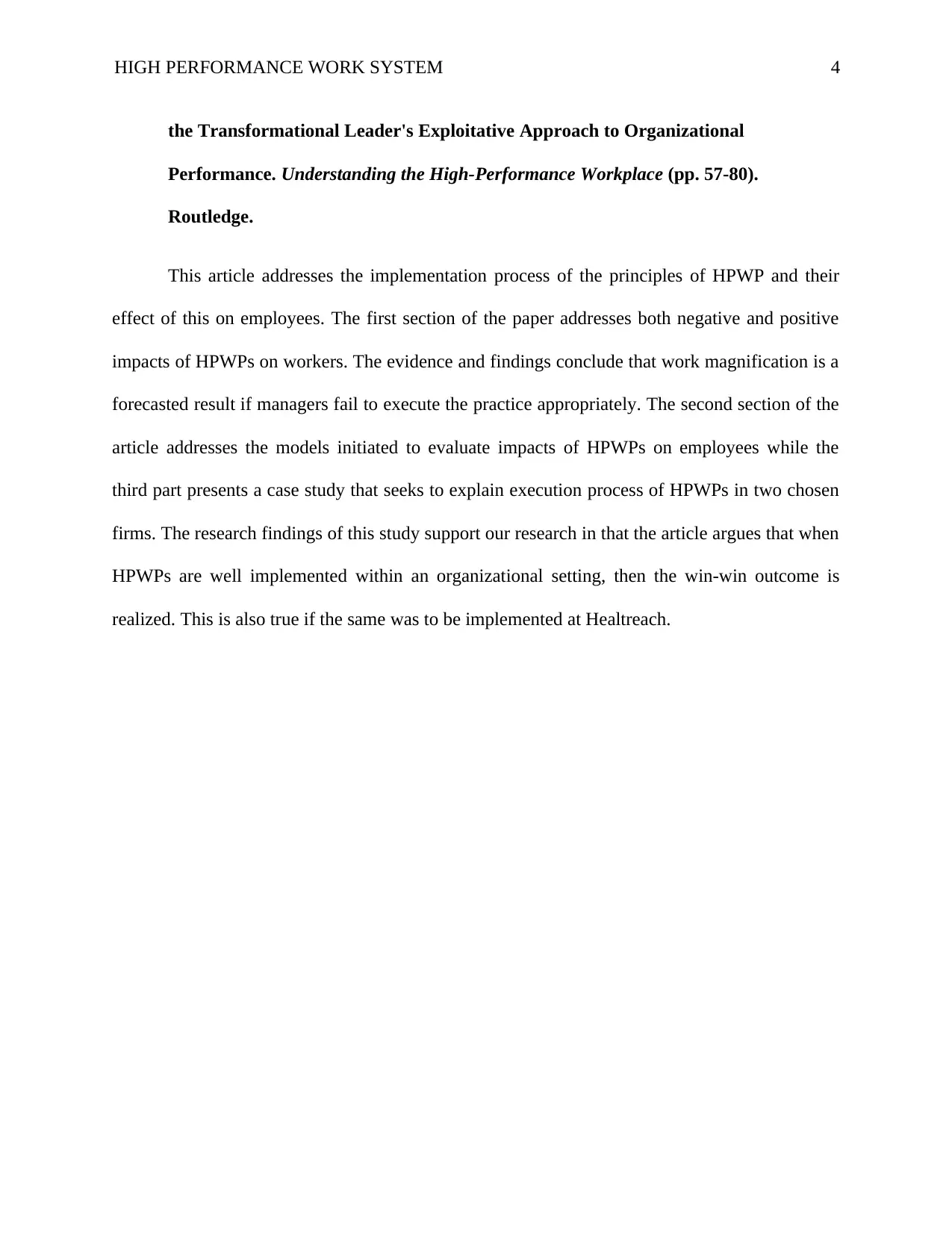
HIGH PERFORMANCE WORK SYSTEM 4
the Transformational Leader's Exploitative Approach to Organizational
Performance. Understanding the High-Performance Workplace (pp. 57-80).
Routledge.
This article addresses the implementation process of the principles of HPWP and their
effect of this on employees. The first section of the paper addresses both negative and positive
impacts of HPWPs on workers. The evidence and findings conclude that work magnification is a
forecasted result if managers fail to execute the practice appropriately. The second section of the
article addresses the models initiated to evaluate impacts of HPWPs on employees while the
third part presents a case study that seeks to explain execution process of HPWPs in two chosen
firms. The research findings of this study support our research in that the article argues that when
HPWPs are well implemented within an organizational setting, then the win-win outcome is
realized. This is also true if the same was to be implemented at Healtreach.
the Transformational Leader's Exploitative Approach to Organizational
Performance. Understanding the High-Performance Workplace (pp. 57-80).
Routledge.
This article addresses the implementation process of the principles of HPWP and their
effect of this on employees. The first section of the paper addresses both negative and positive
impacts of HPWPs on workers. The evidence and findings conclude that work magnification is a
forecasted result if managers fail to execute the practice appropriately. The second section of the
article addresses the models initiated to evaluate impacts of HPWPs on employees while the
third part presents a case study that seeks to explain execution process of HPWPs in two chosen
firms. The research findings of this study support our research in that the article argues that when
HPWPs are well implemented within an organizational setting, then the win-win outcome is
realized. This is also true if the same was to be implemented at Healtreach.
Paraphrase This Document
Need a fresh take? Get an instant paraphrase of this document with our AI Paraphraser
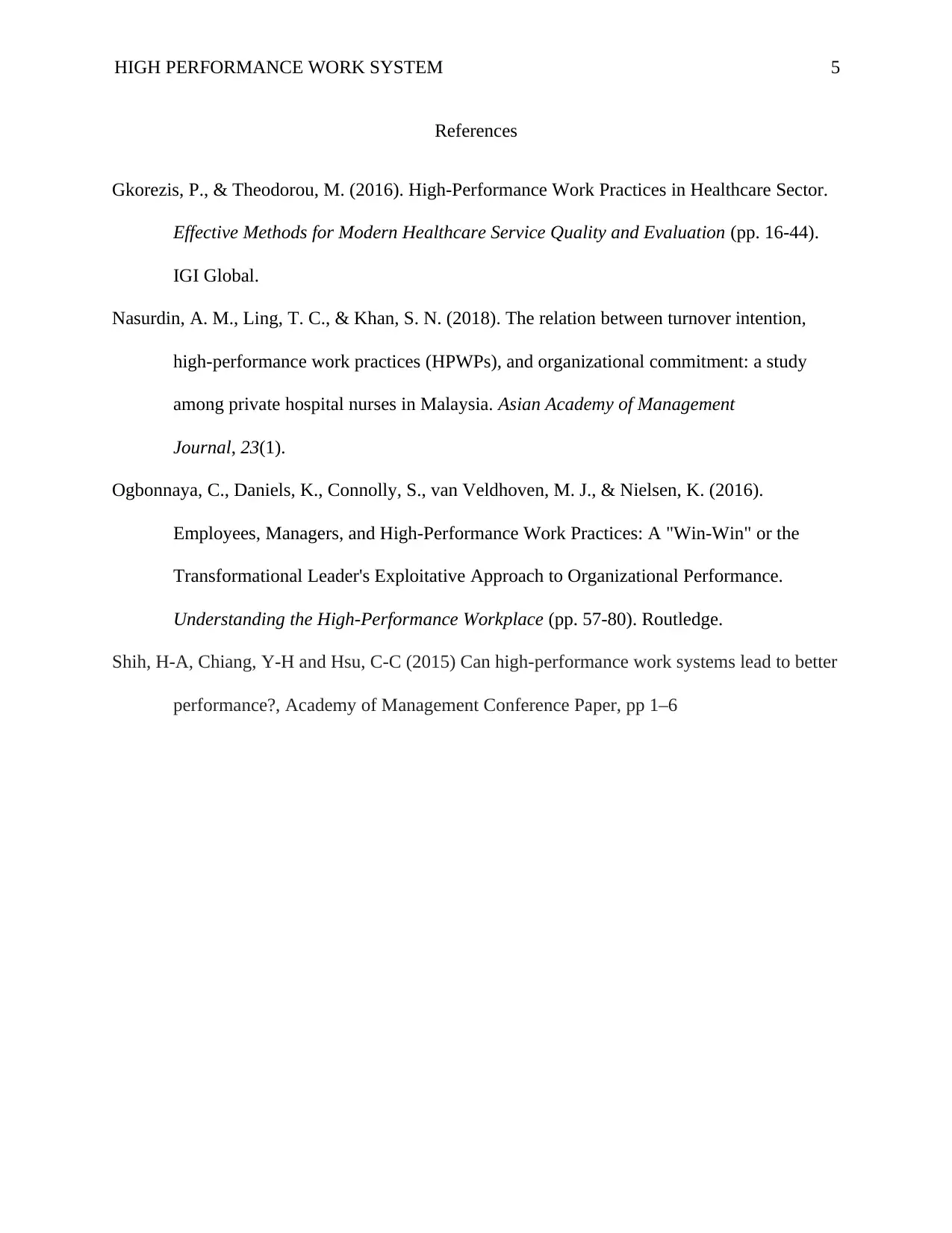
HIGH PERFORMANCE WORK SYSTEM 5
References
Gkorezis, P., & Theodorou, M. (2016). High-Performance Work Practices in Healthcare Sector.
Effective Methods for Modern Healthcare Service Quality and Evaluation (pp. 16-44).
IGI Global.
Nasurdin, A. M., Ling, T. C., & Khan, S. N. (2018). The relation between turnover intention,
high-performance work practices (HPWPs), and organizational commitment: a study
among private hospital nurses in Malaysia. Asian Academy of Management
Journal, 23(1).
Ogbonnaya, C., Daniels, K., Connolly, S., van Veldhoven, M. J., & Nielsen, K. (2016).
Employees, Managers, and High-Performance Work Practices: A "Win-Win" or the
Transformational Leader's Exploitative Approach to Organizational Performance.
Understanding the High-Performance Workplace (pp. 57-80). Routledge.
Shih, H-A, Chiang, Y-H and Hsu, C-C (2015) Can high-performance work systems lead to better
performance?, Academy of Management Conference Paper, pp 1–6
References
Gkorezis, P., & Theodorou, M. (2016). High-Performance Work Practices in Healthcare Sector.
Effective Methods for Modern Healthcare Service Quality and Evaluation (pp. 16-44).
IGI Global.
Nasurdin, A. M., Ling, T. C., & Khan, S. N. (2018). The relation between turnover intention,
high-performance work practices (HPWPs), and organizational commitment: a study
among private hospital nurses in Malaysia. Asian Academy of Management
Journal, 23(1).
Ogbonnaya, C., Daniels, K., Connolly, S., van Veldhoven, M. J., & Nielsen, K. (2016).
Employees, Managers, and High-Performance Work Practices: A "Win-Win" or the
Transformational Leader's Exploitative Approach to Organizational Performance.
Understanding the High-Performance Workplace (pp. 57-80). Routledge.
Shih, H-A, Chiang, Y-H and Hsu, C-C (2015) Can high-performance work systems lead to better
performance?, Academy of Management Conference Paper, pp 1–6
1 out of 5
Related Documents
Your All-in-One AI-Powered Toolkit for Academic Success.
+13062052269
info@desklib.com
Available 24*7 on WhatsApp / Email
![[object Object]](/_next/static/media/star-bottom.7253800d.svg)
Unlock your academic potential
Copyright © 2020–2025 A2Z Services. All Rights Reserved. Developed and managed by ZUCOL.





